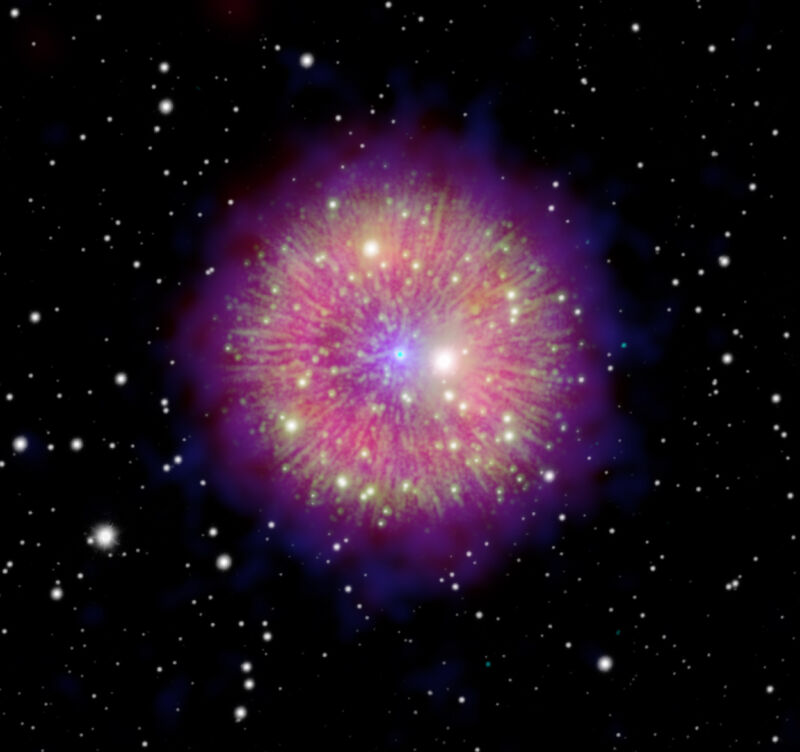Imagine a celestial spectacle that lights up the night sky for an incredible 185 days. That’s the kind of show our ancestors witnessed in the year 1181 when a brilliant supernova erupted within the constellation Cassiopeia. Today, astronomers can peer into the remnants of this stellar explosion, aptly nicknamed SNR 1181, thanks to advanced telescopes and sophisticated image-processing techniques.
Unveiling the Remnant with Chandra’s Keen Eye
A recently released composite image from NASA’s Chandra X-ray Observatory offers a breathtaking view of SNR 1181. This image isn’t just a single observation; it’s a masterpiece woven from data collected across the electromagnetic spectrum. Telescopes like ESA’s XMM-Newton, NASA’s Wide-field Infrared Space Explorer, and ground-based observatories in Arizona and Hawaii all contributed their unique perspectives, allowing astronomers to create a comprehensive picture of the remnant.

The Nebula and the Enigma at its Heart
The Chandra image showcases a magnificent spherical nebula, roughly 16 light-years in diameter. At its center lies a tiny yet brilliant star, glowing aqua in the composite image. This star, a scorching white dwarf, is believed to be a product of the 1181 supernova. Scientists theorize that the explosion resulted from the catastrophic merger of two white dwarfs in a thermonuclear event known as a sub-luminous Type Iax supernova. However, the key detail that separates SNR 1181 from typical supernova remnants is the presence of the white dwarf itself.
The Rise of the “Zombie Star” and its Fiery Breath
Ordinarily, the collision of two white dwarfs in a supernova would obliterate both celestial bodies, leaving behind nothing but a rapidly expanding shockwave and a blast of radiation. But in the case of SNR 1181, the explosion appears to have been incomplete. This twist of fate has resulted in the unlikely survival of a stellar remnant – a “zombie star” – that now resides at the heart of the nebula.
This phoenix-like star is a testament to the universe’s resilience. It ranks among the hottest stars in our Milky Way galaxy, burning at a staggering temperature of approximately 200,000 degrees Celsius (360,032 degrees Fahrenheit). Despite its undead nickname, this “zombie star” is far from inert. It continues to expel a stellar wind at mind-blowing speeds exceeding 16,000 kilometers per second (9,942 miles per second). This stellar wind carves its mark on the surrounding nebula, shaping its structure and contributing to its ongoing evolution.
A Window into the Past
While we refer to this as an 800-year-old supernova remnant, it’s important to remember the vast distances involved in astronomy. The 800 years signify the time it took for the light from the supernova to reach Earth in 1181. Given its immense distance of roughly 10,100 light-years away, astronomers estimate that the actual supernova likely occurred a staggering 10,900 years ago. The immense distance translates to the light taking that long to travel and reach our telescopes.
A Legacy of Light and a Glimpse into the Future
The discovery of SNR 1181 offers a fascinating glimpse into a celestial event witnessed by our ancestors centuries ago. The image serves as a reminder of the dynamic and awe-inspiring nature of the universe, where even stellar explosions can leave behind unexpected survivors like the “zombie star.” The lingering nebula and its fiery central star will continue to be studied by astronomers, providing valuable insights into the complex physics of supernovae, stellar evolution, and the potential for stars to cheat death, at least for a while. Future observations may shed light on how this “zombie star” interacts with the surrounding nebula and how long it can defy its seemingly inevitable fate.



















